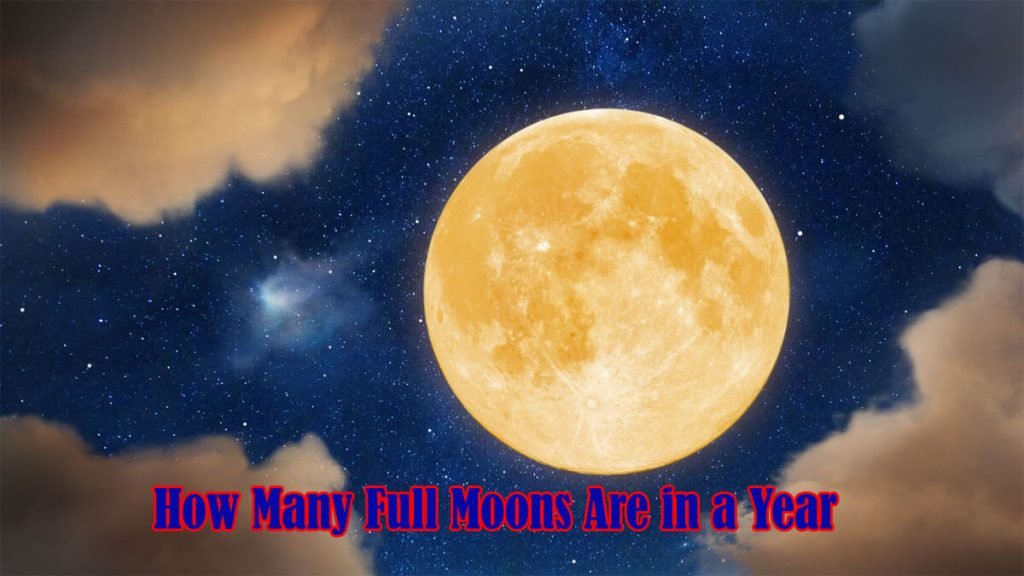How Many Full Moons Are in a Year? Have you ever looked up at the night sky and marveled at the beauty of a full moon? The moon has captivated humans for centuries, and its different phases have been a subject of fascination and wonder. One common question that arises is, “How many full moons are there in a year?” In this article, we will explore the answer of How Many Full Moons Are in a Year to this intriguing question and delve into the world of lunar cycles.
Understanding Lunar Phases
Before we delve into the number of full moons in a year, it’s essential to understand the concept of lunar phases. The moon goes through various phases as it orbits around the Earth, resulting in different portions of the moon being visible from our perspective. These phases include the new moon, crescent moon, first quarter moon, gibbous moon, and, of course, the full moon.
The Definition of a Full Moon
A full moon occurs when the moon is positioned opposite the sun, with the Earth between them. In this alignment, the entire side of the moon facing the Earth is fully illuminated, giving us the mesmerizing sight of a round, glowing moon in the night sky. The full moon is a remarkable celestial event that has captured the imagination of people across cultures and time.

The Frequency of Full Moons in a Year
On average, there are 12.37 full moons in a year. This means that most years will have 12 full moons, with an occasional year having 13. To understand why this variation occurs, we need to examine the lunar and solar calendars.
Lunar Calendar Systems
Traditionally, many cultures used lunar calendars to track time. These calendars were based on the moon’s phases and divided the year into lunar months. Each lunar month comprised a complete cycle of the moon, from one new moon to the next. However, lunar months are approximately 29.5 days long, resulting in a shorter time span compared to the solar year.
The Variations in the Number of Full Moons
As a result of the discrepancy between the lunar and solar cycles, there are occasional variations in the number of full moons in a year. A standard calendar year consists of 365 days, while a lunar year consists of approximately 354 days. This misalignment causes the lunar months to shift relative to the solar months.
To compensate for this misalignment, some cultures incorporated an extra month into their lunar calendars every few years. This adjustment helps to keep the lunar and solar calendars more closely aligned, reducing the discrepancy in the number of full moons observed within a year.
Cultural Significance of Full Moons
Full moons hold significant cultural and religious importance in many societies. They have been associated with various rituals, celebrations, and festivals throughout history. For example, in certain cultures, full moons mark the beginning or end of religious observances, agricultural activities, or hunting seasons.
The Impact of Full Moons on Nature
Full moons have been linked to certain natural phenomena. For instance, the gravitational pull of the moon affects ocean tides, leading to higher high tides and lower low tides during full moons. Some studies suggest that full moons may also influence animal behavior, such as mating patterns or migration.
The Relationship Between Full Moons and Human Behavior
There is a long-standing belief that full moons can affect human behavior, leading to increased emergency room visits, more accidents, or heightened emotional states. However, scientific research has failed to establish a consistent correlation between full moons and these phenomena. The notion of “lunar lunacy” remains a subject of debate among scientists.
Common Misconceptions about Full Moons
Full moons have often been associated with various myths and misconceptions. One common misconception is that full moons are more significant or brighter than other moon phases. In reality, the moon’s brightness remains fairly consistent throughout its orbit, and the full moon appears brighter due to its complete illumination.
Factors Affecting Moon Visibility
The visibility of the full moon depends on several factors, including atmospheric conditions, light pollution, and the moon’s position in the sky. Cloud cover, pollution, or obstructions on the horizon can affect the clarity of the moon’s appearance.
Lunar Photography and Observation
Full moons provide excellent opportunities for lunar photography and observation. Many photographers and astronomy enthusiasts capture the stunning details of the moon’s surface during this phase. Observing the moon through telescopes or binoculars can reveal intricate features, such as craters, mountains, and maria (dark, flat regions).
Full Moons in Popular Culture
Full moons have often been depicted in literature, art, and popular culture. They have been associated with mystical elements, werewolves, and supernatural events in folklore and fiction. The iconic image of a full moon rising above a dark landscape has become an enduring symbol in movies, books, and visual arts.
Full Moons and Astrology
In astrology, full moons are believed to have a significant influence on human emotions and energy. Astrologers associate specific meanings and effects with each full moon, based on the zodiac sign in which it occurs. Full moons are considered a time of heightened intuition, emotional release, and transformation.
Full Moons as a Source of Inspiration
The beauty and allure of full moons have inspired countless poets, writers, and artists throughout history. They have been a source of inspiration for creative works, symbolizing beauty, mystery, and the interconnectedness of the universe. Full moons evoke a sense of awe and wonder, reminding us of the vastness and grandeur of the cosmos.
Conclusion
In conclusion of How Many Full Moons Are in a Year, the number of full moons in a year averages around 12.37. However, due to the differences between lunar and solar calendars, the exact number can vary. Full moons have cultural, natural, and symbolic significance, captivating humanity’s imagination for centuries. Whether you gaze at the moon for its aesthetic appeal, seek its influence in astrology, or simply appreciate its poetic beauty, the full moon remains a celestial wonder worth celebrating.
FAQs About How Many Full Moons Are in a Year
Are there exactly 12 full moons in every year?
No, on average, there are 12.37 full moons in a year, resulting in some years having 13 full moons.
Do full moons affect human behavior?
While many believe in the influence of full moons on human behavior, scientific research has not provided consistent evidence to support this claim.
How does the moon’s brightness change during a full moon?
The moon’s brightness remains relatively constant throughout its orbit. The full moon appears brighter due to its complete illumination.
Can full moons affect animal behavior?
Some studies suggest that full moons may influence animal behavior, particularly in relation to mating patterns or migration.
Why are full moons significant in astrology?
Astrologers associate specific meanings and effects with each full moon, based on the zodiac sign in which it occurs. Full moons are believed to impact emotions and energy levels.


